

State Machine Replication for the Masses with BFT-SM A R T Hsin-Yang Huang Chih-shang Chen
Outline 1.Introduction 2.BFT-SMART Design 3.Implementation 4.Alternative Configuration 5.Evaluation 6.Lessons Learned 7.Conclusion
Introduction Reason: 1.PBFT’s architecture does not fully exploit modern hardware 2.UpRight exhibits a performance significantly lower than other systems. Characteristic: 1.Java-based 2.high-performance and correctness 3.support reconfigurations of the replica
Design principles ● Tunable fault model ○ non-malicious Byzantine-faults ○ malicious Byzantine-faults ○ Simplified SMR protocol ● Simplicity ○ emphasis on protocol correctness ○ avoid optimizations that could bring extra complexity
Design principles ● Modularity ○ uses a well defined consensus primitive in its core ○ easy to implement and reason about
Design principles ● Simple and extensible application programming interface ○ Provide simple API such us invoke(command) and execute(command) ○ Implemented using a set of alternative calls, callbacks or plug-ins (if API not support some methods) ● Multi-core Awareness ○ Take advantage of multi-core architecture of servers
System model Configuration: 1.n ≥ 3f+1 to tolerate Byzantine faults 2.n ≥ 2f+1 to tolerate Crash faults 3.reconfigure replicas at runtime Links: 1.message authentication code(MAC) over TCP/IP 2.Symmetric keys for replica-replica channel 3.Optional signed request for client-replica channels.
Core protocol ● Total order multicast ○ During normal execution, clients send their requests to all replicas and wait for their replies ○ Total order is achieved through consensus protocol
Core protocol (con’t) State Transfer ● to log batches of operations in a single disk ● take snapshots at different points of the execution in different replicas ● perform state transfer in a collaborative way
Core protocol (con’t) Reconfiguration: ● Initiated by View Manager client ● Must be signed with a special private key ● View Manager sends a special message to the replica that is waiting to be added or removed from the system informing the replica.
Implementation 1.Staged message processing 2.Bounded queue Netty thread ● Check unordered or ordered request ● Verify client’s request Proposer thread ● Assemble a batch of requests ● Transmitting the PROPOSE message Sender thread ● Serialize message and produce a MAC ● Send it using TCP sockets
Implementation Receiver thread ● Deserialize message ● Put it on the inqueue Message processor thread ● Fetch messages from the inqueue ● Process message if they belong to current consensus stage ● Put finished decided batch on decide queue Delivery thread ● Remove request on client queue ● Invoke service replica to generate replies
Implementation Reply thread ● Fetch request from reply queue ● Send it back to client Request timer thread ● Activated periodically to verify If some requests remained more Than a predefined time.
Alternative Configurations 1. Crash Fault Tolerance (CFT) Every node that do not give a reply is assumed to be in a crashed state. Tolerance: f < n/2 (simple minority) Sol => bypass WRITE step 2. Malicious Byzantine Faults Malicious leader to lasuch undetectable attacks. Sol => periodic leader changes
Evaluation 1. Raw throughput and Latency 2. Performance in different systems 3. The performance of a BFT-SMART-based system when withstanding faults and reconfiguration.
Raw Throughput and Latency
Raw Throughput and Latency Result 1: CFT setup is always better than BFT Result 2: Payload size increases -> BFT-SMART performance decreases
Raw Throughput and Latency
Performance in Different System
Performance of BFT-SMART-based System Replica 0~3 Replica 1 becomes new leader Replica 3 exits Replica 0~4 Replica 0 recovers
Performance of BFT-SMART-based System Replica 0~3 Replica 1 becomes new leader Replica 3 exits Replica 0~4 Replica 0 recovers
Performance of BFT-SMART-based System Replica 0~3 Replica 1 becomes new leader Replica 3 exits Replica 0~4 Replica 0 recovers
Performance of BFT-SMART-based System Replica 0~3 Replica 1 becomes new leader Replica 3 exits Replica 0~4 Replica 0 recovers
Performance of BFT-SMART-based System Replica 0~3 Replica 1 becomes new leader Replica 3 exits Replica 0~4 Replica 0 recovers
Lessons Learned 1. BFT in Java 2. How To Test BFT 3. Dealing with Heavy Load 4. Maintenance & Robustness
Lessons Learned 1. BFT in Java a. Easy to use b. Feasible implementation of secure software Notice: Need to be used carefully! 2. How To Test BFT a. Test on JUnit b. Identify the malicious behaviors => carefully analyze c. How to inject code for malicious behaviors on replicas => AOP or simple commented code
Lessons Learned 3. Dealing with Heavy Load a. Late f replicas in message processing (cuz only needs n-f to progress) b. non-Ordered requirements c. Thrashing: dropping down throughput under heavy load 4. Maintenance & Robustness a. Complex but completed
Core protocol ● Total order multicast ○ During normal execution, clients send their requests to all replicas and wait for their replies ○ Total order is achieved through consensus protocol
Lessons Learned 3. Dealing with Heavy Load a. Late f replicas in message processing (cuz only needs n-f to progress) b. non-Ordered requirements c. Thrashing: dropping down throughput under heavy load 4. Maintenance & Robustness a. Complex but completed
Conclusions 1. This paper mainly report the process and results in building BFT-SMART library. 2. Describing how to implement the protocol in a safe and efficient way.
Thanks for Listening
Recommend
More recommend